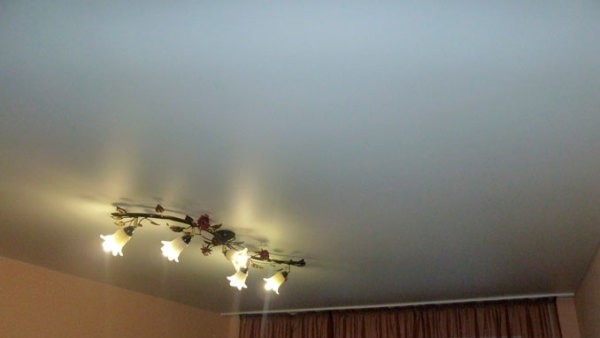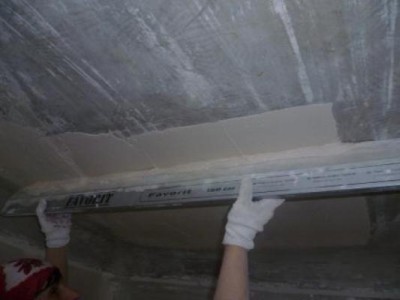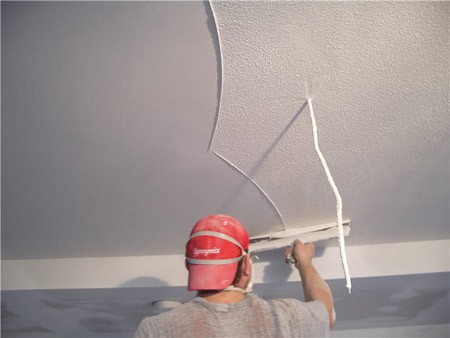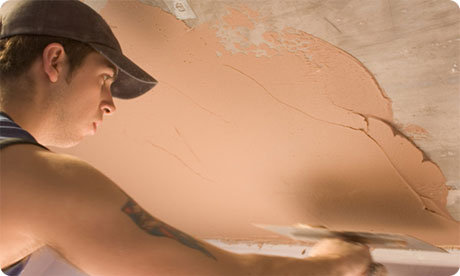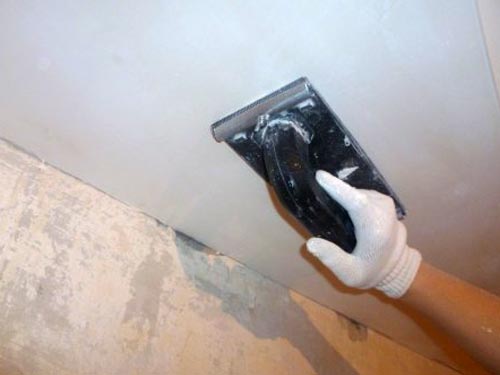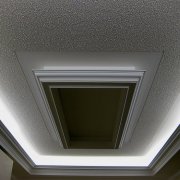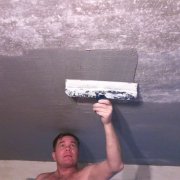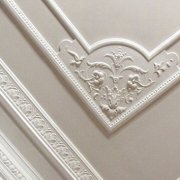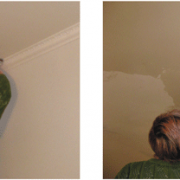How not to make a mistake when choosing plaster for the ceiling
Do you have to decide whether to plaster the ceiling? You can always apply other finishing materials, but plaster to this day remains the most popular material. In principle, any material can be applied to this coating with your own hands and then the price will not be significant.
Today we will talk about the implementation of this work in detail. Also in the video in this article and photo you will see the most difficult moments and this will greatly speed up the work.
The content of the article
Why is stucco attractive?
What to choose plaster for the ceiling is decided primarily on the material of manufacture of the ceiling itself. Indeed, today it can be several materials. It is also worthwhile to understand how much this coating is suitable in your case, it is probably better to just cover it with another material. So let's see what we achieve by applying this coating.
Pros:
- This is the best option in terms of efficiency. Stucco allows you to refine the ceiling without a lot of money. Cassette and suspended ceilings are much more expensive than building mixtures.
- Almost all mortar for plaster environmentally friendly to humans and the environment. After all, neither cement nor gypsum emit any substances harmful to health.
- Plastering the ceiling has another indisputable advantage - it does not conceal the height of the room. The thickness of the plaster layer does not exceed 5 centimeters.
- It is worth noting that suspended and suspended ceiling coatings also do not significantly reduce the height of the room. It depends on which materials are selected.
Minuses:
- Plastering the ceiling surface is not expensive in the event that it is carried out independently. If you use the services of a master, then you will have to pay a lot of money for the work. After all, this work is quite expensive.
- Plastering conceals level differences between ceiling surfaces and walls. only in a limited range of 5 centimeters. The reason for this is not so much the colossal consumption of building material as a threat to life. A thick layer of plaster may not stay on the ceiling and falling, causing irreparable damage to human health until death.
- For plastering, you must have experience in performing this type of work. Many types of suspended ceilings can be installed quite well even by a person who has never done this before. But plastering large surfaces is unlikely to be possible for a beginner. From the first time it is very difficult to achieve a flat ceiling surface, which is necessary for painting (see How to paint the ceiling with paint: do it yourself).
How to perform plastering
What are the first steps you need to take when performing plastering the ceiling surface now we will consider. Here, in the first place is the material of the ceiling, and the preparation of the plane will depend on it.
Surface inspection
First of all, it is necessary to decide: is the ceiling plaster really necessary?
- If surface level differences are five millimeters or lessthen you can do only puttying the ceiling. To do this, use the wide spatula and the rule.
- If the difference is more than five centimeters, then plastering is a danger to humans. Beginners should limit the plaster layer to a level of 3 centimeters.
Surface preparation for plaster
Consider the most unfavorable option: the old layer of plaster is destroyed in places and has fungal lesions, the ceiling surface is replete with numerous cracks and drops in height levels.
How to prepare the surface in this situation:
- First you need to moisten the entire surface to be treated with water. The procedure should be repeated twice with a frequency of 2 to 3 hours. This will soften the old plaster layer so that it can be removed more easily later. Wetting significantly reduces dust levels.
- Using a hard trowel, it is necessary to clean the ceiling surface so that the floor slabs are visible. To clean complex areas, use a hammer drill. The joints between the plates must be freed from plaster, which is weakly held.
- The remaining cement dust and lime can be washed off with a sponge dipped in water.
- The next step is the processing of areas affected by mold. The minimum surface area to be treated should be 20 centimeters. In rooms with high humidity, the entire ceiling is treated.
Attention: It should be noted that any liquid containing chlorine in its composition is suitable for the destruction of mold and fungus (this can be an ordinary "White" or a similar tool). But the antiseptic primer, in addition to getting rid of the fungus, does not allow it to appear again. In this case, the savings are impractical.
- The final stage of the preparatory work includes priming the surface of the ceiling using any primer. This will allow to strengthen the outer concrete layer and improve its adhesion with the stucco mixture.
Which plaster to choose
It is no secret that plastering concrete ceilings is significantly different from how plastering is applied on clay ceilings. Different compositions are simply applied here.
The preparation of the solution and the rules for application will depend on them. Let's immediately consider what we have on the sales market and what a particular composition is better for. On each package there is of course an instruction that needs to be studied, but you also need to approach certain material features.
Cement-based plaster mixes
If you are thinking about how to plaster a concrete ceiling, then this composition is suitable in most cases. The highest durability and long period of operation distinguishes plaster for ceiling surfaces based on cement.
Attention: This plaster is able to provide a uniform smooth coating, moreover, it is universal. Suitable for interior decoration of rooms with humidity of varying degrees, and for decoration of building facades.
Cement plaster not everyone likes it, because cracks often appear on it. But this is not so. Cracking of the plaster layer can occur due to a violation of the rules for the preparation of the mixture and the technology of applying it to the ceiling surface.
Typical and most common errors are listed below:
- First of all, this is non-compliance with the ratio of the components of the mixture recommended by the manufacturer of the plaster. Cement refers to materials with high sensitivity to sudden changes in temperature conditions of humidity. Drying, cement can cause significant shrinkage. Modern stucco mixtures incorporate various fillers. In this case, sand of different types of fractions serves as a filler. Fillers provide a higher density to the structure of the plaster, which reduces the stress of the plaster layer during the hardening process.
- Many people do not take into account the fact that the substrates on which the plaster is applied have a different degree of moisture absorption. The base, made of a material that quickly absorbs moisture, must be primed before plastering. If you ignore this stage, then the plaster layer due to moisture loss can dry out and become covered with numerous cracks.
- Too fast drying of the treated surface often leads to cracks in the plaster coating. It is unacceptable to speed up the drying process using a fan heater or a hair dryer, creating drafts. Indeed, the plaster will dry incorrectly: the outer layer will be covered with a dry crust, and moisture will remain inside. This will certainly lead to cracking of the surface.
Gypsum-based plaster mixes
Plastering a wooden ceiling and plastering a ceiling made of drywall with this material will be most acceptable. As a result, you get a smooth and even surface.
Plaster mixtures based on gypsum have a number of obvious advantages:
- Unlike cement plasters, gypsum mixtures dry much faster. For complete drying, they need only a few hours;
- Gypsum plaster have excellent adhesive characteristics, which is an important aspect when performing the decoration of the ceiling surface;
- Maintain a favorable microclimate of the room, absorbing excess moisture and giving away the missing;
- Differ in advanced composition. This is achieved by adding fine quartz, perlite or lime sand.
The disadvantages of gypsum-based plasters include the limitation of the scope. This coating is very sensitive to high humidity.
- To perform plastering with gypsum mortar, the ceiling surface in the bathroom, first of all, it is necessary to ensure good ventilation of the room. Gypsum plaster has the ability to dry quickly, which limits the time to complete the work. This is a pretty big problem for beginners. Currently, gypsum-based mixtures with the addition of substances that increase the time range for performing work have appeared in construction stores.
- Additives are an important component of plaster mixes, although they make up no more than one percent in the total volume. Using various additives, plaster mixtures give a number of additional useful properties that were not previously available. There are additives that can hold moisture, there are those that increase the adhesive and antiseptic properties of the material. This allows you to improve the quality of repair work.
Clay-based plaster mixes
Plastering clay ceilings with this composition will be the most optimal, because the homogeneity of the composition will ensure adhesion of surfaces and a long service life.
Plaster clay mixes can simultaneously solve a number of problems:
- You can do without buying a clay solution, and cook it yourself. Clay is quite common in nature. Therefore, it can be found to prepare a solution in its own area, digging a hole one and a half meters deep. To make the mixture in clay, you need to add some components.
- Clay is an environmentally friendly material. It is not harmful to human health.
- Due to the fact that the purchase of plaster mixture is not required, the cost of repair work is reduced.
Clay also has important positive technical characteristics:
- A high degree of flexibility allows it to be used even in regions with increased seismic activity. Clay is as flexible as lime plaster. It is not susceptible to cracking.
- Long term of operation in any climatic conditions.Clay is not afraid of a high level of humidity, changes in temperature, strong gusts of wind.
- Clay is capable of fairly quick recovery. There is no need to replace the entire coating, only those areas where there is damage can be repaired.
- Clay has an average level of vapor permeability. Clay solution is characterized by excellent hygroscopic characteristics.
- Due to the structure of ionic bonds, it has excellent protective properties against insects and other pests.
Finishing work
Complete leveling the ceiling surface with putty. If gypsum-based plaster was used, then it is allowed to immediately apply the final layer of putty.
- Work is carried out with a wide spatula. Beginners are advised to be guided by the following sequence: with the necessary period of time for drying, putty is applied in two thin layers, after which the surface of the ceiling is ground.
- Grinding is carried out using a hand grater with a mesh for grinding. This method is only suitable for small surfaces. For large areas, it is more advisable to use a grinding machine. To carry out this work, a respirator or gauze dressing is required.
Helpful information
Some tips to help you approach home decoration in a new way.
- Finishing the surface of the ceiling with Venetian stucco (seeVenetian plaster: features of the use of material) is not often performed, it is mainly used for walls. Previously, it included marble chips and beeswax. Currently, the binder component is acrylic resin.
- It is not recommended to use this type of plaster in bathrooms and toilets. When flooding from the top floor, the plaster will be damaged, which will lead to its peeling. It is impossible to choose the right shade of the coating, it will be necessary to plaster the ceiling surface again.
- Looks great on the ceiling textured plaster. It is not suitable for the kitchen because it will be problematic to remove dust from such a surface. The best option is to use polymer-based textured plaster. It does not wear off when washed. She is not afraid of high humidity. This distinguishes it from silicate and mineral analogues.
- Plaster layer repair usually consists of two stages: remove old layers and closing cracks. Old plaster is tapped to reveal exfoliated strata and the spaces beneath them. All areas with identified defects are cleaned to a concrete base. With a knife or putty knife, the cracks expand, after which the primer of the defect is primed and puttyed.
- After the putty is completed, it is recommended to apply another primer layer on it, only then you can start painting the ceiling. The work performed will add surface strength and improve the degree of adhesion to the paint. It will also help reduce paint consumption.
Do not question the economic component of the issue: with the same quality characteristics, water-based paint is much more expensive than a primer. How to plaster a ceiling from drywall video will help you visually see the whole process, the most important thing is not to rush and apply proven and high-quality materials.
